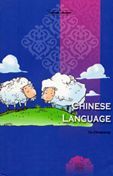Chinese Language
Publisher:
China Intercontinental Press
Publication:
1/2011
Languages:
English
Binding:
Hardcover
ISBN/SKU:
9787508520186
Pages:
174
Sizes:
226 x 156mm
Weight:
0.3500
On OrderTo be dispatched within 4 weeks
Special Price
£20.46
£20.46
Regular Price
£21.95
(€22.92)
This book begins with a general introduction of various Chinese languages, languages of different Chinese ethnic groups as well as the majority Han people. The relation between Mandarin Chinese and Chinese dialects is also explained with fair clarity. Through reading the introduction, you will learn why Mandarin Chinese has become the Common Language (Putonghua) of the nation, how Chinese written characters evolved into the present form, and what differences exist between the classic and modern language, and between the formal written style and informal speech. In addition, the system of Mandarin Chinese Pinyin and Tones are introduced in detail to serve as a threshold for exploring the contents of the book. After the introduction are six chapters elaborating on the distinctive features of Mandarin Chinese, respectively in terms of its phonology, tones, morphology and syntax. In each chapter, typical and practically usable examples are provided along with annotation of the tones and translations, so as to help readers learn with ease.
Annotating Abbreviations
Chapter One: An Overview of the Chinese Language
Languages of the Han Chinese and Chinese Ethnic Groups
Mandarin, Putonghua and Chinese Dialects
Classic Chinese and Modem Chinese
The Speech and Writing of Modern Chinese
Chinese Characters and Their Changes
Pinyin and the Computer Input of Chinese Characters
Chapter Two: The Phonology of Mandarin Chinese
Classification and Representation of Pinyin Sounds
Simple Initials
Compound Initials
Simple Finals
Compound Finals
Summary: All Pinyin Sounds
Special Cases: Sound Change (Sandhi)
Chapter Three: Tones of Mandarin Chinese
The Tone and Meaning in Mandarin Chinese
Change of Tones in Context
The Light Tone Suffix in Orientation Words
Summary
Chapter Four: Chinese Words and Phrases
Chinese Word Structures
Content Words and Function Words
Substantive Words
Predicate Words
Function Words
Word Groups
Chapter Five: The Basic Structures of Chinese Sentences
Sentence Components and Word Order'
The Sentence Subject
The Sentence Predicate
Chapter Six: Complex Sentences and Compact Sentences
The Complex Sentence and Simple Sentence
Complex Relations and Connectives
Compact Sentences
Compact Sentence Connectives
Omission of Connectives in Compact Sentences
Chapter Seven: Summary: Features of Chinese Mandarin
Chapter One: An Overview of the Chinese Language
Languages of the Han Chinese and Chinese Ethnic Groups
Mandarin, Putonghua and Chinese Dialects
Classic Chinese and Modem Chinese
The Speech and Writing of Modern Chinese
Chinese Characters and Their Changes
Pinyin and the Computer Input of Chinese Characters
Chapter Two: The Phonology of Mandarin Chinese
Classification and Representation of Pinyin Sounds
Simple Initials
Compound Initials
Simple Finals
Compound Finals
Summary: All Pinyin Sounds
Special Cases: Sound Change (Sandhi)
Chapter Three: Tones of Mandarin Chinese
The Tone and Meaning in Mandarin Chinese
Change of Tones in Context
The Light Tone Suffix in Orientation Words
Summary
Chapter Four: Chinese Words and Phrases
Chinese Word Structures
Content Words and Function Words
Substantive Words
Predicate Words
Function Words
Word Groups
Chapter Five: The Basic Structures of Chinese Sentences
Sentence Components and Word Order'
The Sentence Subject
The Sentence Predicate
Chapter Six: Complex Sentences and Compact Sentences
The Complex Sentence and Simple Sentence
Complex Relations and Connectives
Compact Sentences
Compact Sentence Connectives
Omission of Connectives in Compact Sentences
Chapter Seven: Summary: Features of Chinese Mandarin




